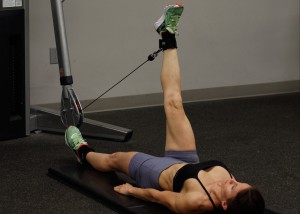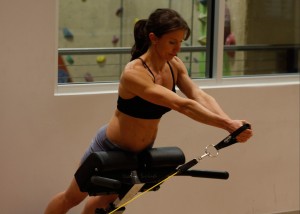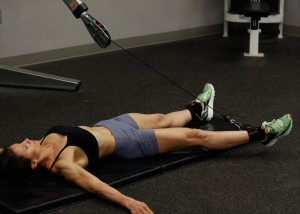By: Sofia Bunger
Most climbers know that a strong core improves your climbing. Trainer Adam Macke explains how advanced strengthening can add more power to your climbing by doing these exercises. But first, our conversation started with the basic question, “What is the core?”
There isn’t a core. Apples have cores but the human body is more sophisticated.
To describe the “core” he explains that the hip and spine muscles centered in the body contract to support the force production of the extremities and also stresses that the strength of those muscles are more important than those of your fingers.
The ability to transfer body load away from the fingers will increase actual contact strength. Flexing, extending, and rotating the hip and spine creates more inward and downward pressure onto the hands thus producing more surface friction at the fingertips. The action of the hips with a foot on the wall applies force to the fingers, making the hip and spine the axis point.
Concluding that the strength of the lumbo pelvic hip complex are what actually keeps your fingers on the wall, he explains how to improve contact strength by focusing on those muscles.
Climbers typically choose exercises that resemble climbing. Some of these exercises are not appropriate for strength training and can detour from good climbing technique. For example, most hanging exercises like campusing, can be less effective as strength training.
A typical climber’s core training may include hanging leg lifts. This exercise can be beneficial for some climbers initially but not in the long-term. While they are a great gauge to measure strength, Macke considers it inappropriate for advanced strengthening as there is no resistance at zero degrees of hip flexion and full resistance at 90 degrees. Instead, completing the same joint motion is possible by laying supine on the floor with an ankle-strap attached to a cable. This applies more load to the hip and creates a resistance profile that matches the strength profile of the muscle, thus maximizing the strength of the hip flexors.

Recently climbers have identified the benefits of training hip extension, for example by doing deadlifts. Deadlifts are a great exercise except they offer little to no resistance at full hip extension.
In climbing, the hip tends to be loaded in full extension and not challenged as much in flexion, especially on steep walls. Macke suggests complementing the deadlift with a hyperextension or glute-ham apparatus that uses body resistance and can be easily advanced with external forms of resistance.

Crunches and situps are other popular exercises commonly used by climbers. These exercises are difficult to add resistance to and he suggests using a decline ab-board. The ab-board allows significant resistance to be added appropriately while having the opportunity to add rotational resistance.

Climbers neglect the importance of hip abductors and the external rotators. On steep angle climbing the posting leg must be able to maintain enough force to keep the hips into the wall. Weak climbers tend to relax the hip muscles allowing the feet to cut and rely on finger tension only. Strong hip abductors combined with back extensors allow the fingers to maintain their grip.
Traditionally those exercises are done standing, Macke found that having the climber lying on the floor, they were able to focus on maximum abduction instead of attempting to balance while standing. He also adds that this is a great opportunity to work on internal and external rotation of the hip.


Most exercises train in the sagittal plane; while climbing, we not only move in the sagittal plane but we move through the transverse plane putting extreme tension on the hip and spinal muscles. Attempting to strengthen these muscles in orchestration, for example as in functional or kettlebell training, the athlete tends to use the path of least resistance, minimizing the load effect on individual muscles. Instead, these muscles must be strengthened in isolation to maximize force production.
In conclusion, Macke feels strongly that climbers should use isolation exercises to strengthen muscles, however, he also points out that it is important to spend more time doing actual climbing and training drills to learn the necessary recruitment patterns to apply their strengths.
Adam Macke has more than 15 years of experience in strength training for athletes. He is certified in Resistance Training and Muscle Activation Techniques. Combining his expertise with his passion for athletic performance Macke has through the years helped countless of climbers improve their performance by eliminating pain, tightness and weaknesses.

These exercises remind me of Reformer Pilates! Do you guys have any articles on specifics: which exercises for what, how may reps, how many times a week, etc?
LikeLike
We are just now seeing this reply and apologize for the lateness! Although we enjoy sharing various types of exercises, each of us needs to be assessed in order to determine which exercise, load, intensity, frequency is applicable for the individual. Progression is a process and many variables need to considered before we add load to the body.
LikeLike